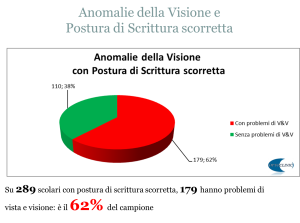Almost illegible and messy handwriting may be misclassified as dysgraphia, but may instead be due to problems in learning to write by hand, on which it is very important to intervene.
The dysgraphia is a specific learning disorder (D.S.A.), which manifests itself with poor handwriting and makes handwriting more or less illegible as it is untidy, extended outside the margins, with segmented strokes, with frequent use of block letters instead of cursive. In some cases, however, this disorder can be misdiagnosed, because one is, in reality, faced with a 'false dysgraphia', which derives from a lack of or inadequate education in the grapho-motor gesture, the basis of learning to write by hand.
 A screening conducted by Optoclinic, an ophthalmic-optometric studio in Pisa, on 470 primary school pupils in Pisa who were part of the 'Vision and Posture at School' project, showed that 95% of them had an incorrect writing posture and 62% had vision abnormalities associated with it. It was revealed that under these conditions the notebooks were rotated up to 90° in order to be able to see what was being written, setting in motion a series of visual and postural compensations harmful to the apparatus involved.
A screening conducted by Optoclinic, an ophthalmic-optometric studio in Pisa, on 470 primary school pupils in Pisa who were part of the 'Vision and Posture at School' project, showed that 95% of them had an incorrect writing posture and 62% had vision abnormalities associated with it. It was revealed that under these conditions the notebooks were rotated up to 90° in order to be able to see what was being written, setting in motion a series of visual and postural compensations harmful to the apparatus involved.
It must be considered that prolonged dysfunctional sitting postures lead to paramorphisms that are particularly harmful in those who have not yet reached maturity in bone development because, if not re-educated, over time they become dysformisms, i.e. irreversible structural alterations.
False dysgraphia can be fully corrected through the intervention of specialised professionals, such as orthoptists, optometrists, posturologists, speech therapists and educationalists.
Among the most recent publications on this topic is the 2023 volume 'False dysgraphia and related visuo-postural vices' by Dr. Coralie Delliponti (Fabiano Gruppo Editoriale), with a section dedicated to neuro-ophthalmology by Dr. Valerio Lupi, ophthalmologist.
